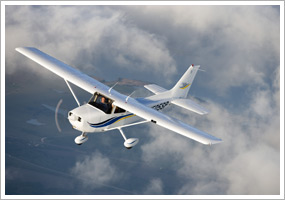| SPONSOR |  | TRAINING TIPs  Taking on turbulence Taking on turbulence Few pilots wake up in the morning and say, “It’s going to be a very bumpy day. I should get out there and fly!” One exception may be your flight instructor, who at a certain point in your training may be thinking along those exact lines. The traditional introduction of a new pilot to the lumps and bumps of an atmosphere on the move is gradual, or at least unpredictable—not a lesson plan in itself. But turbulence is a fact of life of aviation weather, so the sooner a pilot gets used to the idea that turbulence and its ergonomic discomforts may arise at any time, the better. Getting ready to fly when the bumps are already known to be out there is part preflight planning, part mental prep. How should you adjust your piloting technique? How does your aircraft behave in bumpy air? Begin your research with a glance out your kitchen window. Stratiform clouds often tell a story of stable, smooth air. Cumulus clouds suggest convective currents and thermal turbulence, especially during warm weather. Altocumulus standing lenticular clouds developing downwind of mountains warn of severe turbulence. Next check precautionary statements in the area forecast (FA). They are discussed in Chapter 12 of the Pilot’s Handbook of Aeronautical Knowledge. Look over pilot reports from your briefing, noting the time, location, altitude, and type of aircraft involved. When preflighting, secure your baggage, for safety and to preserve a correct center of gravity. Be sure the baggage load does not exceed the published limit. “The limit is based primarily on the strength of the aircraft structure. It doesn't mean the floor will buckle if you put 201 pounds in a baggage hold limited to 200 pounds. It does mean that you increase the risk of overstressing the structure in extreme turbulence or under maximum certificated acceleration (G) loads,” wrote Mark Twombly in the November 2001 Flight Training column “What it looks like: When baggage is properly secured.” Try the Air Safety Institute’s online Aerodynamics course, which features an interactive weight-and-balance exercise. Windy day departures need specialized technique; review with your instructor. Read this AOPA Aviation Forum post of how one pilot’s experience made him question his method. Planning a long day’s ride? Prolonged flight in turbulence can bring on fatigue. Know the warning signs and stay alert. Training tames turbulence, producing a confident, more skillful pilot. YOUR PARTNER IN TRAINING Spring can be a capricious time of year when it comes to planning a flight. When you start the cross-country phase of your training, AOPA’s weather tools can help you. Plan a theoretical flight and check radar, surface analysis, METARs, and other reports to see whether your proposed trip could actually get off the ground. Ask your flight instructor to check your findings. Did you know that student pilots who join AOPA are three times more likely to complete their flight training? Membership includes unlimited access to aviation information by phone (800/USA-AOPA, weekdays from 8:30 a.m. to 6 p.m. Eastern time) or from Flight Training Online or AOPA Online. If you're not already a member, join today and get the pilot’s edge. Login information is available online. FLIGHT TRAINING NEWS Flight instructor code of conduct released The Flight Instructors’ Model Code of Conduct, a set of operating practices developed by a team of aviation professionals, was announced April 18. The guidelines cover seven sections: general responsibilities of instructors; students, passengers, and people on the surface; training and proficiency; security; environmental issues; use of technology; and advance and promotion of aviation instruction. Read more >> Test your knowledge of instrument approach procedures An instrument approach is simply a step-by-step procedure for getting you safely on the ground when the weather puts a damper on your visibility. But knowing the steps in advance is crucial to a successful outcome. Test your understanding of instrument approach procedures by taking the newest Air Safety Institute safety quiz, sponsored by the AOPA Insurance Agency. Flight training grant for Chicago-area students A & M Aviation, based at Bolingbrook’s Clow International Airport in Bolingbrook, Ill., has announced a grant program open to high school students in the southwest suburbs of Chicago. The recipient will earn a private pilot certificate and all expenses will be paid. Training will take place June 6 to Aug. 31, and eligible applicants must be age 17 by Aug. 31. For more information and an application, see the website. Breitling contest features pilot certificate as top prize So the saying goes, a picture is worth 1,000 words. But in the Breitling photo contest, a picture could be worth a private pilot certificate or a flight with the Breitling Jet Team in Dijon, France. The company is hosting a photo contest on its Facebook page for aviation enthusiasts to submit up to five pictures each that capture how much they love aviation. Photos can be submitted through May 17. Read more >> Flight school managers find help at conference Attendees at the second annual International Flight School Operators Conference April 13 through 15 learned effective management techniques and got to network with other flight school managers. The conference was hosted by the Flight School Association of North America (FSANA). Speaker David Meador, a national champion in blind golf, inspired attendees to overcome personal and business challenges to continue doing what they love: teaching others to fly. FSANA is a membership organization that represents flight schools and firms that provide products and services to the flight training or aviation industry. North Dakota students building airplane Students in Bismarck Public High School’s Career Academy in North Dakota are building an airplane that will be flyable when the project is complete. The students, who are enrolled in the second-year aviation program, are building a full-scale Piper J-3 Cub replica, according to a report in the Bismarck Tribune. Students in the first-year aviation program work toward completing private pilot ground school and take the knowledge test. Inside AOPA Take the guesswork out of risk assessment As pilots, we make decisions about risk all the time. Some flights are clearly low-risk (think “local jaunt on a calm, clear day”), while others have obvious issues (think “moderate icing in a Piper Cub”). But things aren’t always so clear-cut—which is why the Air Safety Institute developed an innovative online tool to help with the tougher calls. The Air Safety Institute Flight Risk Evaluator lets you input the details of an upcoming flight and get an objective assessment of the potential risks. Try it out before your next flight! Renters: Don’t fly unprotected Now that spring is here and summer is on its way, more and more pilots will be taking to the skies. The cost of aircraft renter’s insurance is affordable for AOPA members, thanks to the efforts of AOPA and the AOPA Insurance Agency. AOPA members will receive a 5-percent discount on renters insurance policies, allowing members to obtain a comprehensive package for just $99 a year. The 5-percent discount applies to both new and renewing policies. Plus, members renewing their AOPA Insurance Agency renter’s policy can take advantage of an additional 10-percent discount if they were claim and accident free during the previous policy year. Visit the AOPA Insurance Agency online to apply and purchase your renter’s insurance policy today, or call 800/622-2672 for more information. Is your certificate at risk? Spring has arrived and for many pilots that means less time on the ground and more time in the air. Unfortunately in today’s climate for general aviation every flight you take could put you at risk of violating any one of at least 700 relevant federal aviation regulations with which pilots are required to comply. Fortunately, as the thousands of AOPA members enrolled in the Legal Services Plan already know, for as little as $33 per year you can enjoy peace of mind every time you fly knowing that if a federal enforcement procedure is yours, you’ll have the best legal advice and support available anywhere. Enroll today >> AOPA Aviation Summit registration opens, prices start at $30 AOPA Aviation Summit registration is open, and exclusive new deals make attending more affordable than ever before. Register now and look forward to AOPA’s world-class exhibit hall, more than 60 hours of educational seminars, and exciting aviation social events. Plus, for the first time in the Northeast, you will have an opportunity to dine with famous aviators and interact with them one on one. Please join us in Hartford, Conn., Sept. 22 through 24. Register today to receive special discount pricing (enter priority code U911EP). TRAINING PRODUCTS Free Plane Manager app from Sporty’s Owning an airplane gives you a lot of freedom along with a lot of new record-keeping responsibilities. Sporty’s Plane Manager app, powered by ShareZen, can help you track maintenance, to-do lists, and other tasks via a secure online server. You also can use it to maintain an online logbook and keep track of your flying schedule. See the website for more information. Note: Products listed have not been evaluated by ePilot editors unless otherwise noted. AOPA assumes no responsibility for products or services listed or for claims or actions by manufacturers or vendors. FINAL EXAM Question: What causes motion sickness, and what are the typical symptoms? Answer: Motion sickness is caused by the constant stimulation of the portion of the inner ear that controls an individual’s sense of balance. The symptoms are normally progressive. Usually the first indication of motion sickness is the loss of desire for food. Saliva then begins to collect in the mouth and the individual begins to perspire. Eventually, a person will feel nauseous and at times disoriented. One also might get a headache and/or vomit. It is possible to become completely incapacitated, if the motion sickness becomes severe enough. For more on motion sickness and what to do if one is suffering from its effects, read the AOPA subject report about motion sickness. Got a question for our technical services staff? Email [email protected] or call the Pilot Information Center, 800/872-2672. Don’t forget the online archive of “Final Exam” questions and answers, searchable by keyword or topic. What's New Online When you start taking trips out of the pattern and to neighboring states, you’ll learn lessons about weather and decision making that will help to build your self-confidence as a pilot. Associate Editor Jill W. Tallman talks about lessons reinforced during a recent trip in the latest Flight Training blog. AOPA Career Opportunities Ever dream of turning your passion for aviation into a career? We’re looking for an application support engineer and member services representative. To learn more about other AOPA career opportunities, visit AOPA Online. Picture Perfect  Pilots love to take photos, and they love to share them with other pilots. Now you can upload your flying photos to our online gallery, “Air Mail.” Share your special aviation images, or view and rate more than 7,500 photos (and growing). Photos are put into rotation on the AOPA home page! Pilots love to take photos, and they love to share them with other pilots. Now you can upload your flying photos to our online gallery, “Air Mail.” Share your special aviation images, or view and rate more than 7,500 photos (and growing). Photos are put into rotation on the AOPA home page! AVIATION EVENTS & WEATHER  Want something to do this weekend? Planning an aviation getaway? See your personalized online calendar of events . We’ve enhanced our calendar so that with one click you can see all of the events listed in the regions you selected when personalizing ePilot . Now you can browse events in your region to make planning easier. You can also bookmark the personalized calendar page to check it as often as you want. Before you take off on an adventure, make sure you check our current aviation weather provided by Jeppesen. Want something to do this weekend? Planning an aviation getaway? See your personalized online calendar of events . We’ve enhanced our calendar so that with one click you can see all of the events listed in the regions you selected when personalizing ePilot . Now you can browse events in your region to make planning easier. You can also bookmark the personalized calendar page to check it as often as you want. Before you take off on an adventure, make sure you check our current aviation weather provided by Jeppesen. To include an event or to search all events in the calendar, visit AOPA Online. For airport details, including FBO fuel prices, see AOPA Airports. Flight Instructor Refresher Clinics The next Air Safety Institute Flight Instructor Refresher Clinics are scheduled in Fort Lauderdale, Fla., and Pensacola, Fla., May 14 and 15; Sacramento, Calif., Kansas City, Mo., Albany, N.Y., and Houston, Texas, May 21 and 22; Orlando, Fla., Charlotte, N.C., and Columbus, Ohio, June 4 and 5; San Jose, Calif., and Minneapolis, Minn., June 11 and 12. For a complete schedule, see AOPA Online. Can’t make it in person? Sign up for the CFI Refresher Online. Air Safety Institute Safety Seminars Air Safety Institute Safety Seminars are scheduled in Blacksburg, Va., April 25; Danville, Va., April 26; Richmond, Va., April 27; Morris Plains, N.J., and Hampton, Va., April 28; Poughkeepsie, N.Y., May 2; Garden City, N.Y., May 3; Cohoes, N.Y., May 4; Rochester, N.Y., May 5; Morganton, N.C., May 7; Salisbury, N.C., Brookings, S.D., and Madison, Wis., May 9; East Hartford, Conn., Jamestown, N.C., Aberdeen, S.D., and Milwaukee, Wis., May 10; Smithfield, N.C., Spearfish, S.D., and Manitowoc, Wis., May 11. Topics vary—for details and a complete schedule, see AOPA Online. | Advertisers                 Got news? Contact ePilot. Having difficulty using this service? Visit the ePilot Frequently Asked Questions now at AOPA Online or write to [email protected].
421 Aviation Way
Frederick, MD 21701
Tel: 800/USA-AOPA or
301/695-2000
Copyright © 2011 AOPA.
|

 Taking on turbulence
Taking on turbulence
